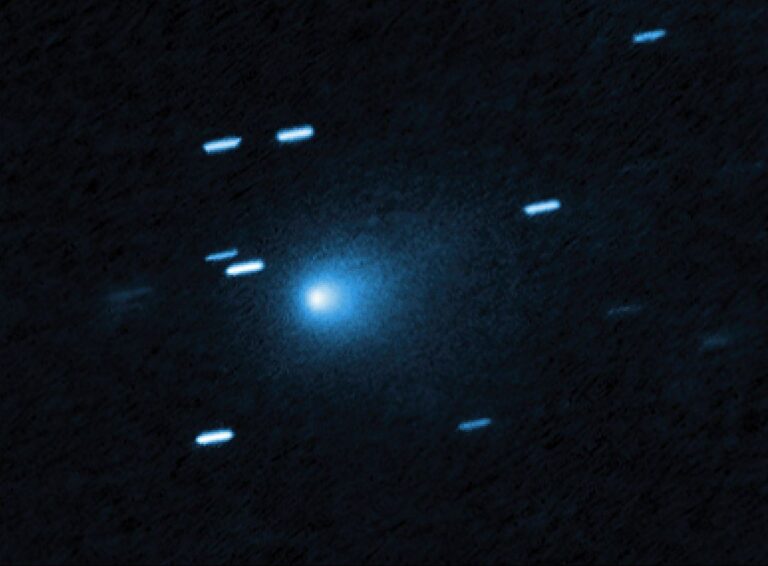Key Takeaways:
The Large Hadron Collider (LHC), the largest and most expensive scientific instrument ever built in peacetime, begins operations this Wednesday, September 10 when a beam of high-speed protons begins shooting around the machine’s 16-mile, 27-kilometer, circular tunnel beneath Geneva, Switzerland.
When the protons collide with each other inside the machine, one thing that scientists are certain won’t happen is the production of miniature black holes that gobble up nearby matter. A new study shows that the continuing existence of old stars in the sky is evidence that small black holes can’t swallow the Earth.
That is not to say that the new collider might not actually create mini-black holes, as no one knows for sure what will emerge from the debris of the LHC collisions. Black holes are thought to represent the ultimate state of compressed matter, with gravity so powerful that any bit of matter, and even light, would be sucked inexorably inwards with no chance for escape if it gets too close to the black hole’s boundary.
That was the thinking about black holes before Stephen Hawking, the Cambridge University scientist, came forth with the idea that even black holes can lose energy. The density of energy inside a black hole is so huge that some of it can be converted into creating new particles, he said. If this conversion happens right at the edge of the black hole, Hawking argued, some of those new particles could escape, taking energy with them. In this way black holes can lose energy. They can “evaporate.”
There is a rule in physics that says that the smaller the black hole, the quicker the evaporation. For an LHC-style black hole, estimated to be only a billionth of a billionth of a meter across (an atto-meter) the black hole would exist for a bit more than a few billion-billion-billionths of a second. It wouldn’t be around long enough to swallow any nearby matter and would pose no danger to ordinary matter.
In their study of the matter, Steve Giddings of the University of California at Santa Barbara and Michelangelo Mangano of the European Organization for Nuclear Research (the parent laboratory where LHC operates) look at what happens if there existed a type of black hole, one we’d be concerned about, that could not only survive but would continue to grow to a macroscopic size in a time shorter than billions of years.
If such a type of black hole existed, it would grow even quicker inside super-compressed stars, such as white dwarfs and neutron stars, where the density of matter is billions or trillions of times greater then the density of rock on Earth. These celestial objects are created when an ordinary star runs out of fuel and starts to contract. There is no LHC on such stars but a black hole could presumably be spawned when a passing cosmic ray, a haphazard shooting particle that races around the cosmos, strikes and burrows inside the neutron star.
Since astronomers look out and see perfectly healthy and very old white dwarfs and neutron stars of the right types, Giddings concludes that quickly-growing black holes, the kind that voraciously eat their surroundings, can’t exist. Such a dangerous black hole couldn’t exist inside dense stars and couldn’t exist on Earth.
Michael Peskin, a Stanford physicist who did not take part in the study, says that the continued existence of superdense stars act like the canaries that coal miners used to take underground — the idea being that the presence of deadly gas would more quickly overcome the canary, giving the miners warning of a dangerous condition. As long as those stars keep sending their light, Peskin says, the Earth is not in danger from black holes
If scientists don’t know for sure what particles the LHC will produce, why build a massive, very expensive machine to smash particles together in the first place? The smashing is needed because to explore the interior of atoms and the power of the collisions of particles is directly related to how deep inside the researchers can see. Increasing the power of the proton beams used in the collisions requires increasing the size of the collider.
Why do the beams have to be so powerful? The answer is related to the idea that energy can be converted from one form into another. The protons at the LHC whiz around their long track at a speed of 99.999999 percent of the speed of light. Actually two beams circulate in the same underground tunnel in opposite directions, and when two protons hit each other head on, a lot of their immense energy of motion can, at the moment of collision, be transformed into new particles that weren’t there a moment before.
When two automobiles hit head-on the results are always bad. But in the world of high-energy physics, instigating a violent smashup, with lots of debris spraying out, is exactly what researchers want. Among the debris can be particles that might have existed billions of years ago but which, because of their instability, long ago decayed away. Creating these rare particles again in a modern experiment is precisely the plan at LHC. The thinking here is that such formerly-extinct species of matter can tell us things about the forces of nature.











